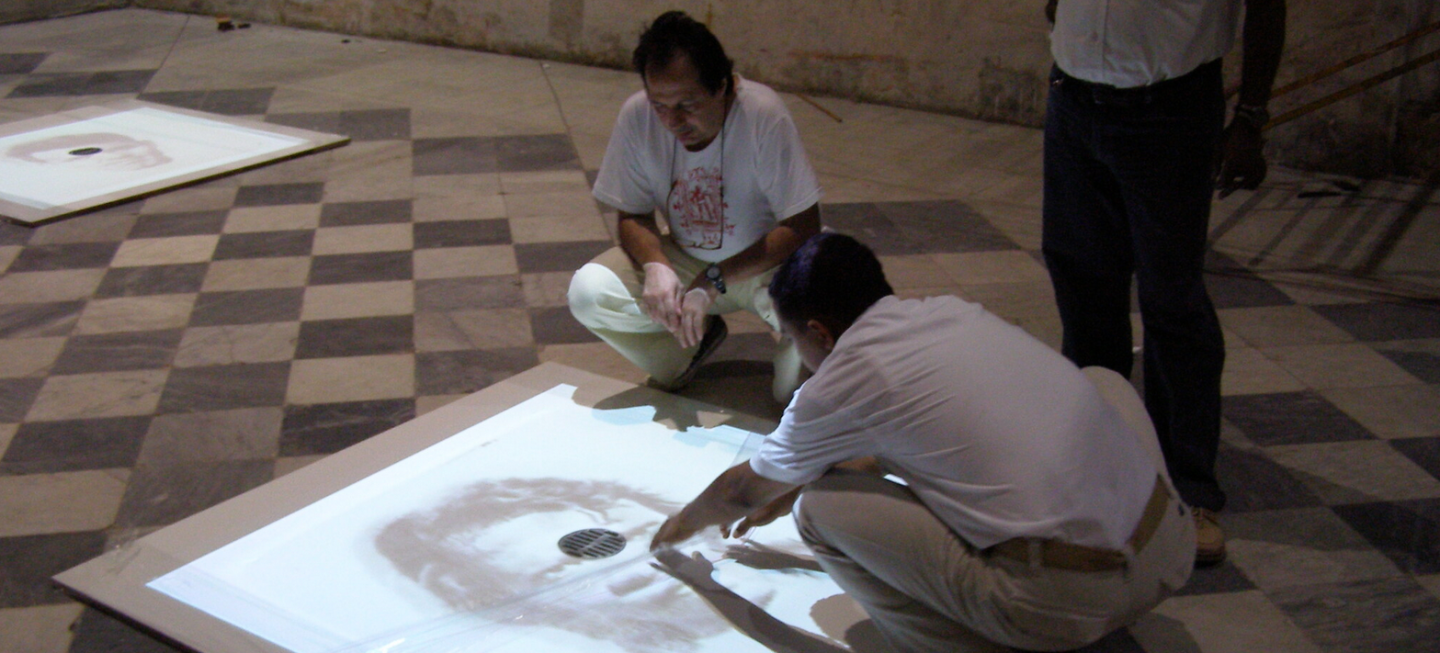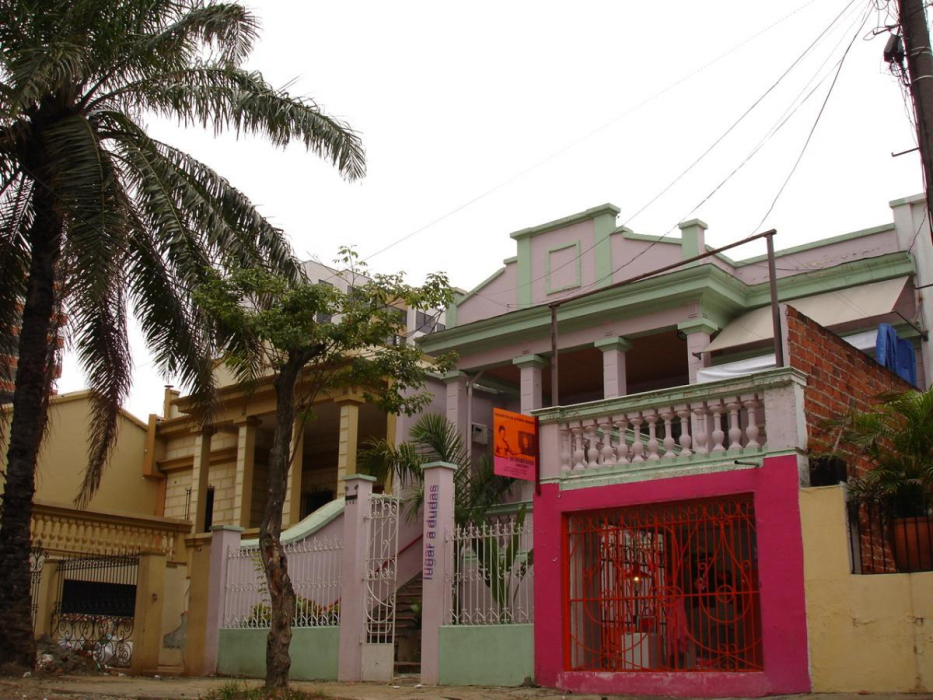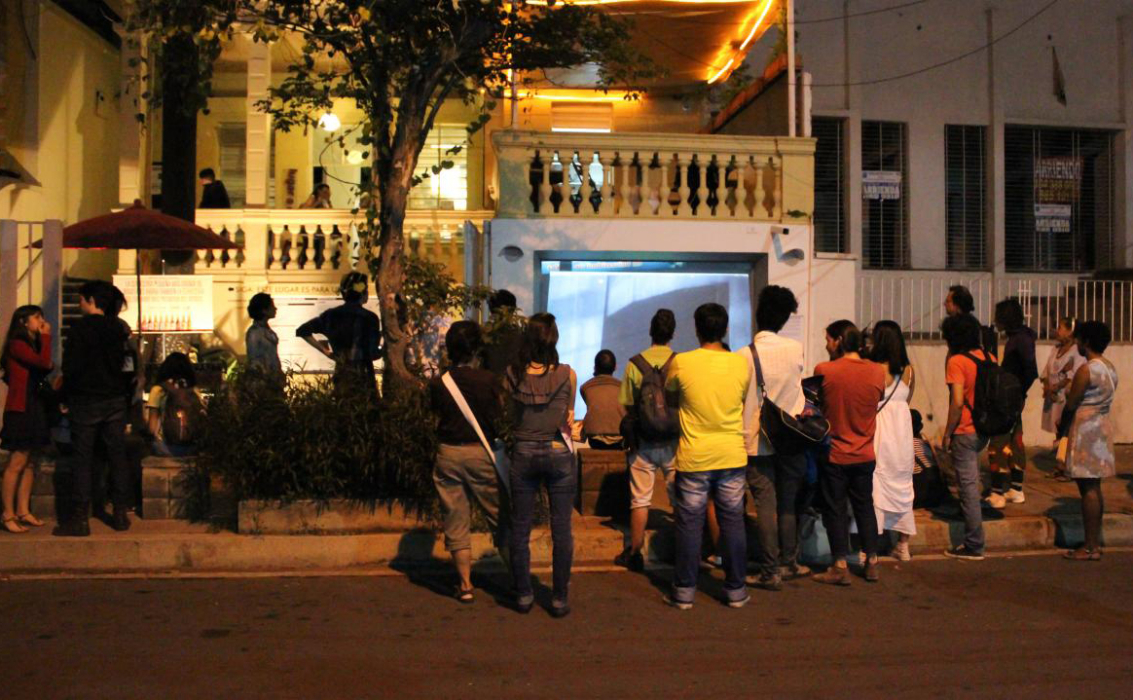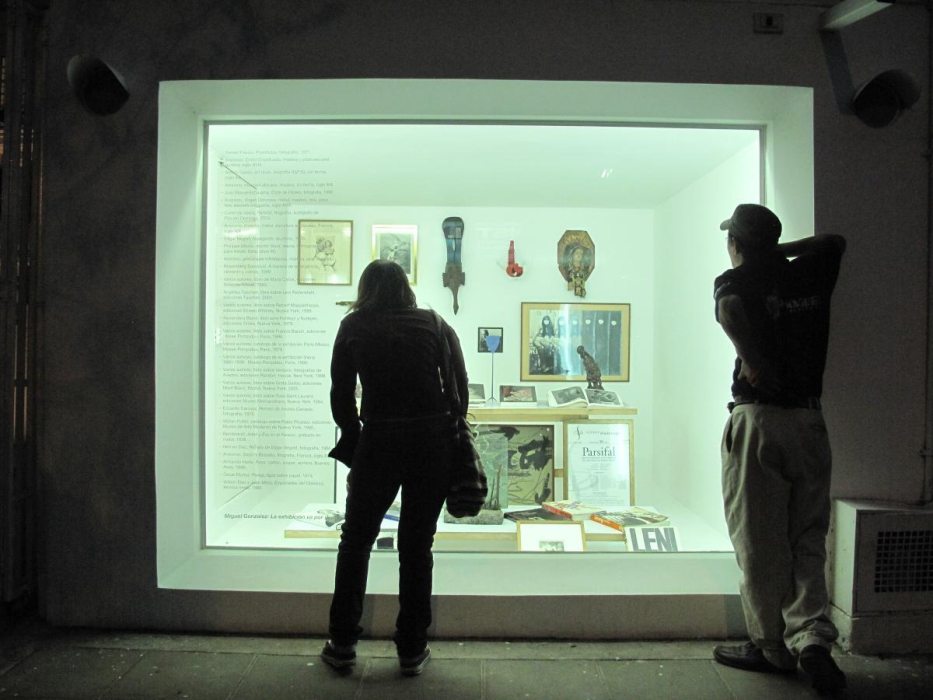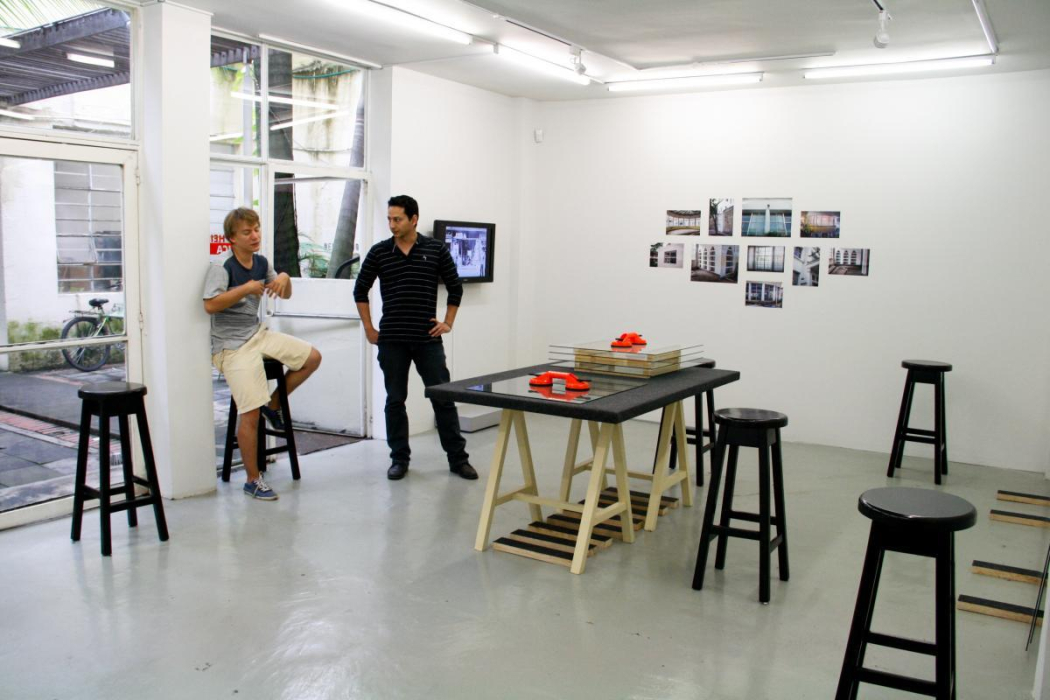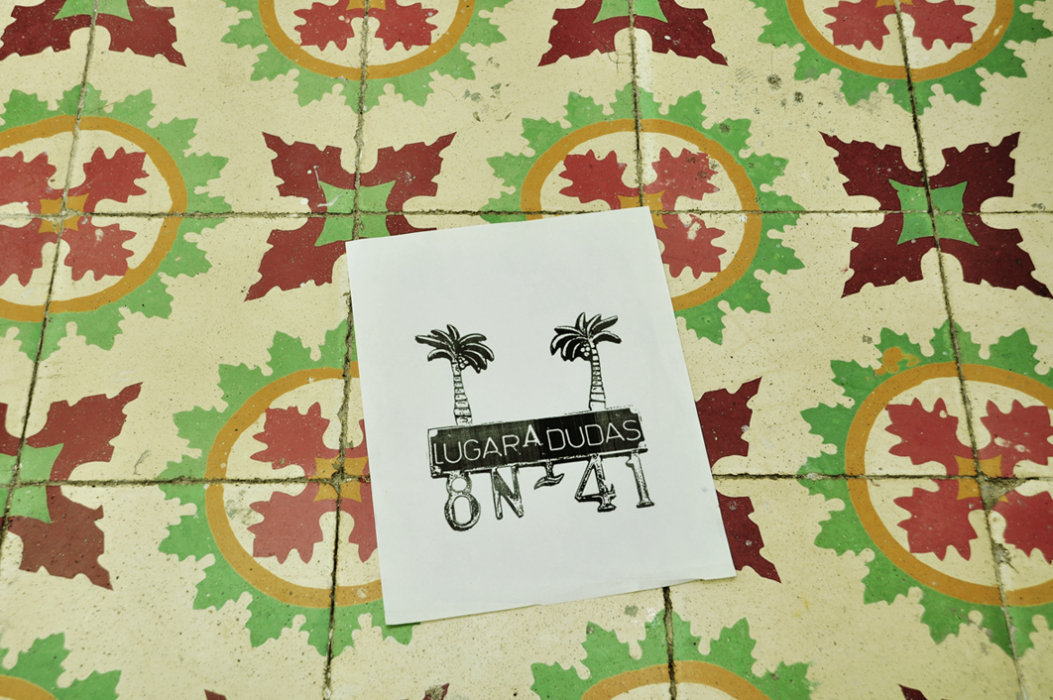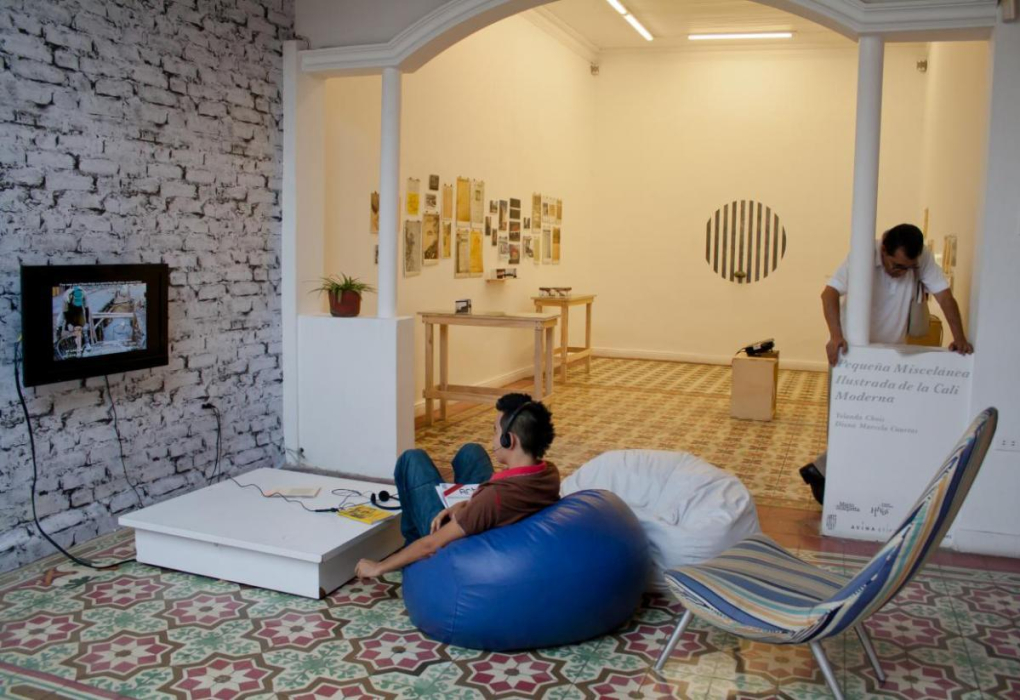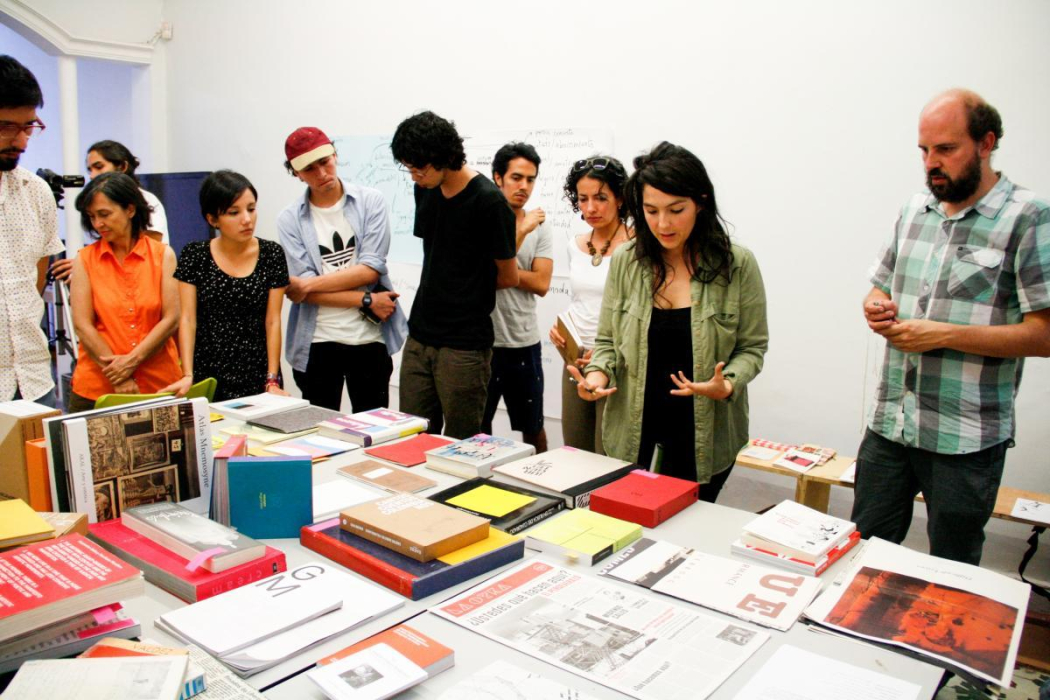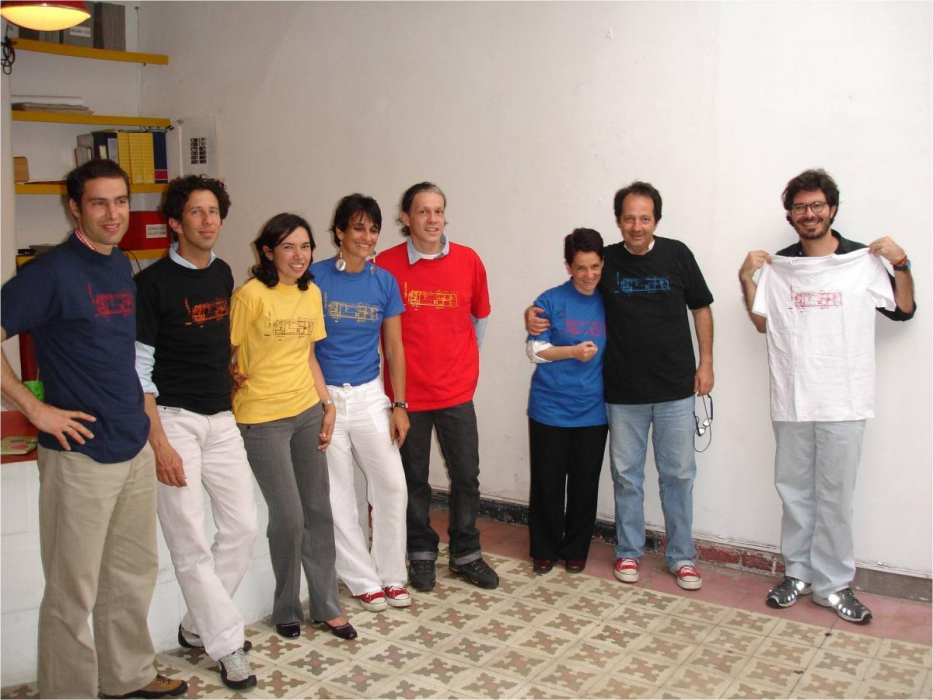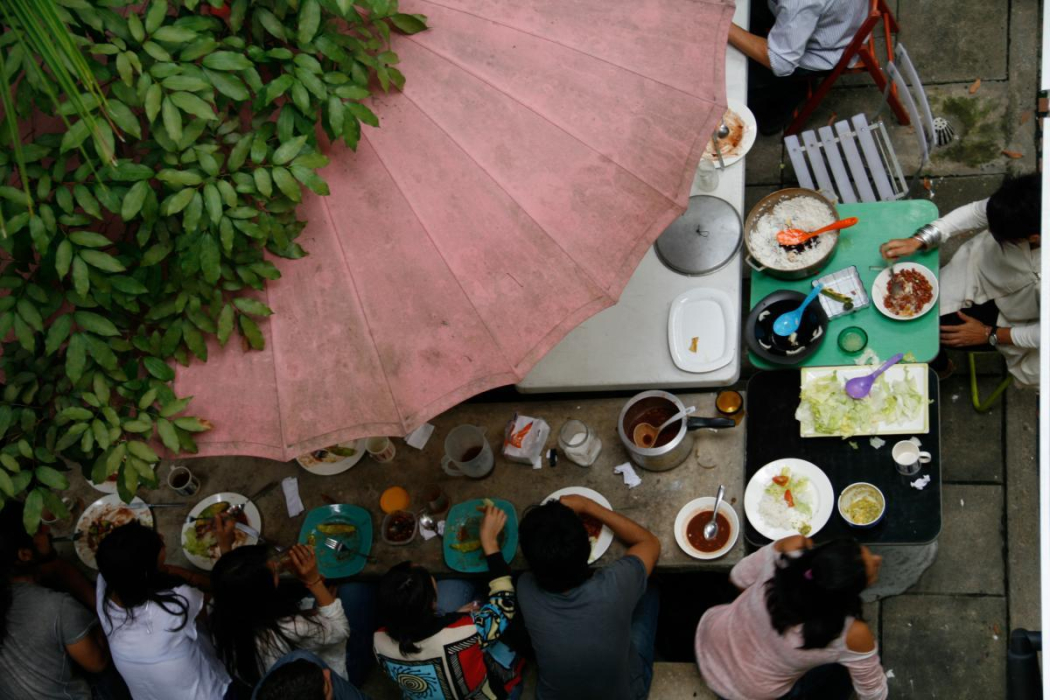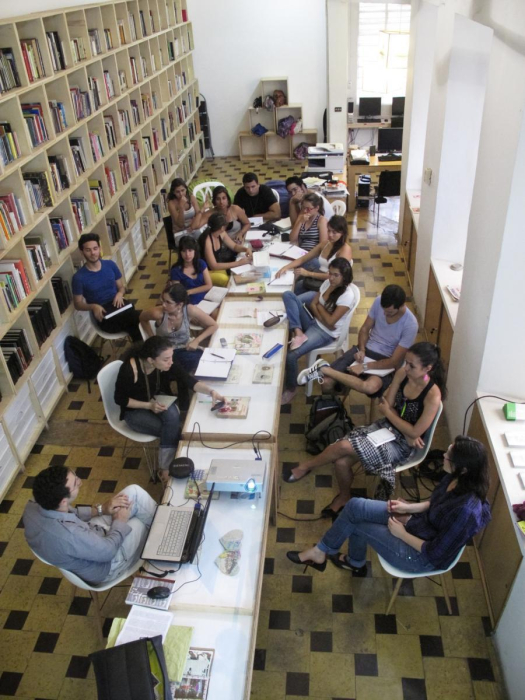2000s
History
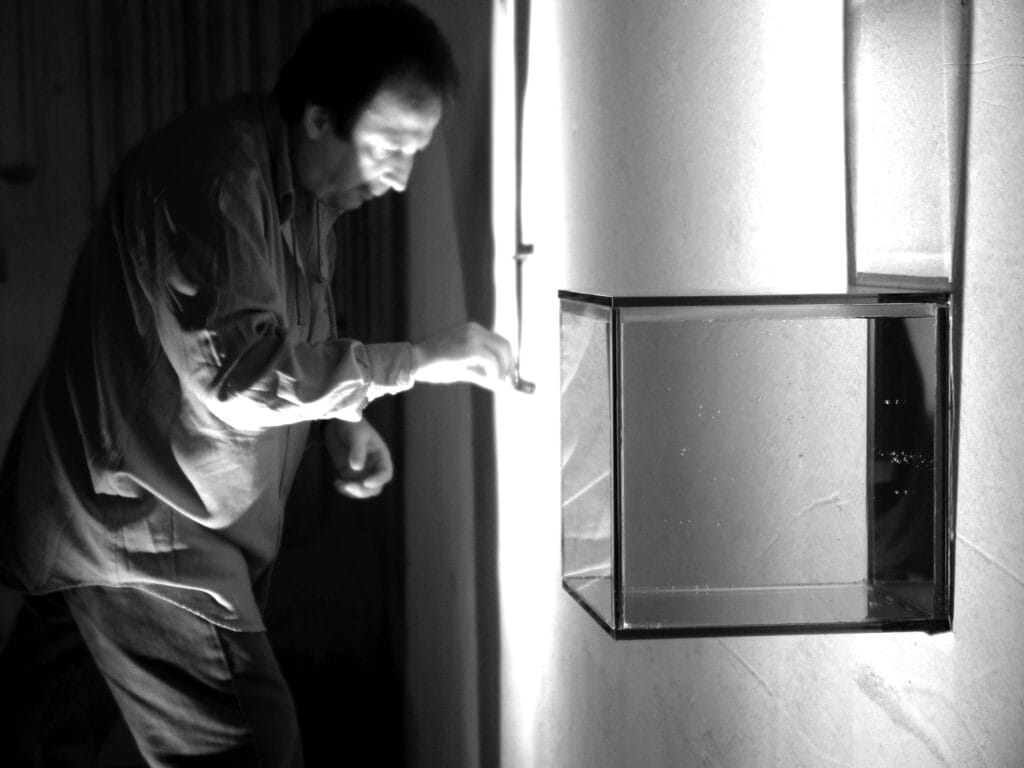
There is a resurgence of criminal violence in Cali by gangs of sicarios unable to make a profit from the drug trade. A sense of insecurity persists in the city.1
2000
History
The FARC (Revolutionary Armed Forces of Colombia) suspends talks to protest what it calls “paramilitary terrorism.”
The Artist
Muñoz produces Tear Collectors with the same process of charcoal screen-printing on water as in Narcissi, but uses three closed, transparent cubes filled with water installed waist-high on the wall and lit from below. As condensation forms, drops fall and distort the image on the surface. These images are portraits of people published in the media, including an assassinated female student.2 Muñoz explains that he began working on this piece “inspired by a violent event, with Saja Kaim, a fine arts student who left for Chocó and never appeared again. One day, I saw her father on a news program narrating the tragedy, supposedly caused by paramilitaries. Among other things, he detailed that the body had been cut open to prevent it from floating in the water. I spoke to people who knew her and began reconstructing her memory, her past, thinking of an image of her that would always float and never sink. Thinking also of Chocó’s very special climate system, where there is a lot of evaporation, a lot of condensation, a very high humidity index.”3
Muñoz produces his first video, Narcissus. He relies on a time-based medium to show how the image—a photographic self-portrait made with charcoal dust deposited on the surface of standing water in a white sink—distorts and disappears as the liquid drains.4 He explains this video is “like a metaphor for a lifetime. It also has that biblical element that you are dust and you become dust again, like that image that changes shape and then disappears. I also include a speaker that produces the sound of the water filling and draining. There is a form of inhalation and exhalation, of filling and emptying, of life and death.”5
Muñoz begins to work on Eclipse, an installation for a room with a long window or windows that can be darkened with a panel perforated by a series of small holes. Circular concave mirrors placed in front of the holes turn the darkened gallery into a camera obscura, reflecting onto the panel an inverted image of the street life outside. The positioning of the mirrors and the shadows they cast emulate the shapes of a lunar eclipse.6 Muñoz also designs the 50,000 pesos bill, the highest denomination in Colombian currency, using motifs related to the nineteenth-century author Jorge Isaacs, a resident of Cali well known for his romantic novel María.
2001
History
President Pastrana holds meetings with the leader of the FARC, Manuel Marulanda, and the leaders of ELN (National Liberation Army), to continue with the peace process. Violence persists with bomb explosions in different cities.
Art/Culture
French sociologist Daniel Pécaut, a specialist on Colombia, publishes War Against Society, in which he introduces concepts like “banality of violence.” For Pécaut, long-term exposure to terrorism results in deterritorization (the feeling that danger is everywhere and no one can be trusted), detemporalization (the sense that violence is continuous and there is no future), and desubjectivization (the lack of a collective imaginary). Under such conditions, violence becomes mythic, everlasting, and naturalized.7
The Artist
Muñoz produces The Cyclops’ Gaze, that consists of six photographs of a plaster cast of his face. Muñoz states, “I begin with a negative, that is to say hollow, plaster mask made of my own face, akin to the funerary custom of making death masks practiced by the ancient Romans, whereby they cast wax masks from molds of the faces of their dearly departed and painted and kept them as images—called imagos. The hollow mask here, however, seems to possess volume, that is, it appears to be convex and the illusion proves so unbreakably strong that we are unable to see it as concave, despite the evident contradiction between the photographer’s hand holding it.”8
2002
History
The candidate for the party Colombia First, Álvaro Uribe, is elected President of Colombia until 2006. During his administration, he follows the policies of the Plan Colombia, partially financed by the United States, to fight narco-terrorism. Kidnappings and assassinations decline. The group Los Rastrojos, named after one of its founders, Diego “Rastrojo” Pérez Henao, is founded in Cali as the armed wing of the Norte del Valle Cartel. Their activity spreads throughout the country, fighting rival crime syndicates. They ally with the Mexican Sinaloa Cartel.
Art/Culture
On November 6 and 7, Doris Salcedo presents her performative installation 280 Empty Chairs, at the Palace of Justice in Bogotá. For fifty-three hours, the duration of the siege of this building in 1985, 280 wooden chairs are slowly lowered from the rooftop, one by one. They hang on the exterior walls of the building, one for every person killed or lost in the siege. Muñoz participates in the art fair Miami/Basel, Miami, Florida and the VIII Bogotá Art Biennial at the Museum of Modern Art of Bogotá.
The Artist
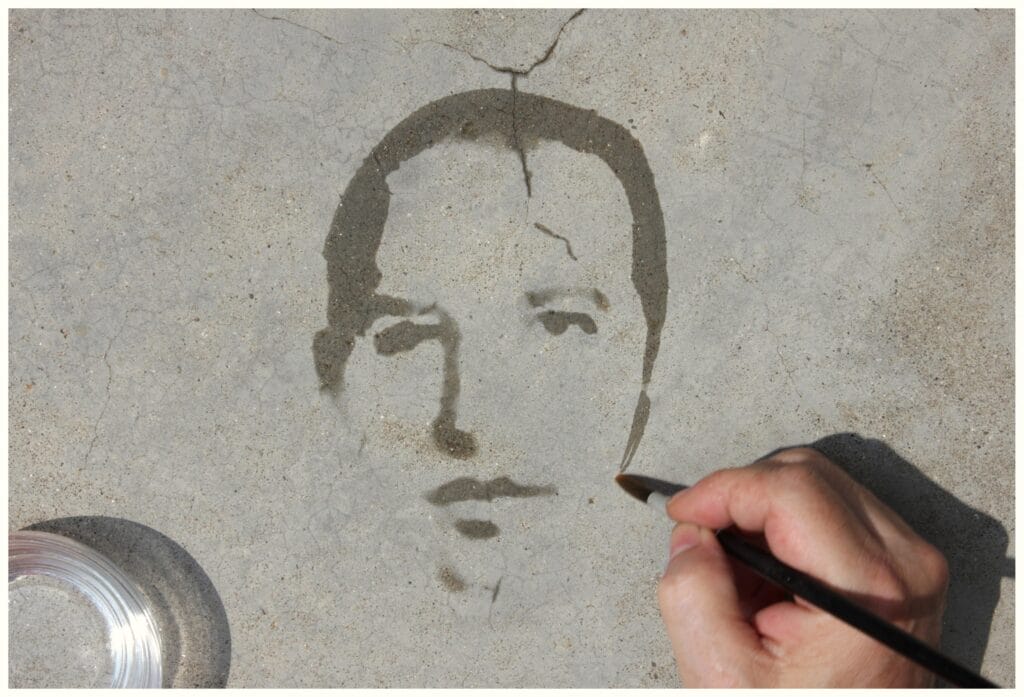
In February, Eclipse is installed at the Santa Fe Gallery, District Planetarium, Bogotá. Muñoz produces Biographies, an installation using a process similar to his video Narcissus. Three videos projected on the ground show charcoal-dust portraits floating on water in a white basin. The images drain away, but then reappear through film editing that reverses the action. These portraits come from the fotocineros archive later included in his project Bycontact Archive.9 Muñoz has several international solo shows: Transfigurations, at the Iturralde Gallery in Los Angeles; The Ends of Process at the Sicardi Gallery in Houston; and Oscar Muñoz in TEORéTICA, San José, Costa Rica. Muñoz stated about his creative process during these years: “It is not possible to forget about the violence surrounding us. Nor is it possible to make something as shocking, sensationalist and immediate as what is taking place. I have to bring it to a different stage and work on it. One needs to take the work to levels beyond the experience that the viewer has of reality, and enrich it…. I seek to reach a more poetic, sensuous, sensitive level that is able to suggest… rather than produce a direct and fleeting emotion. It can’t be the same as when we watch the news, where a past event was covered by the most recent one, and this one will be eclipsed by whatever comes next. That’s an awful trivialization of what’s terrible. One has to find other ways to touch upon these things.”10
2003
History
United Self-Defense Forces of Colombia (AUC), the right-wing counter-insurgent, drug-trafficking paramilitary group, signs the Ralito Accord with Uribe’s government to cease operations.
Art/Culture
Muñoz participates in the Puerto Rico Polygraphic Triennial in San Juan. Doris Salcedo presents Istanbul, an installation of 1,500 wooden chairs, at the 8th Istanbul Biennial. The art gallery Alcuadrado opens in Bogotá (until 2009). It represents important contemporary artists such as Jaime Ávila, François Bucher, María Elvira Escallón, Juan Fernando Herrán, María Teresa Hincapié, Oscar Muñoz, and Miguel Ángel Rojas. Its exhibitions are held in different sites around the city.
The Artist
In January, Eclipse is installed at the Comfandi Hallin Cali. Muñoz creates Palimpsest, which consists of a hand-held mirror modified to allow two people to simultaneously see the other and themselves. He prepares the video Portrait/I Try Again, showing his hand painting an outline of his face with water on cement warmed by the sun. The wet traces dry up before the self-portrait is finished. The artist repeats the action time and again, trying to hold on to the vanishing image, a metaphor for the difficulties of holding on to memories. The exhibition Oscar Muñoz: Portrait/I Try Again, is presented at the Colombian-French Alliance, Bogotá. This idea is later expanded in 2005 in Project for a Memorial that features five videos showing this action.
Referring to his long-standing interest in drawing Muñoz affirms: “For me, working with water was the same. This cannot be understood as a retreat from drawing, as it seems to me that they are drawings too. I think that because of this transparency they are closer to graphic art and drawing than to painting.”11
Muñoz begins to plan a cultural center in Cali called Lugar a Dudas (Room for Doubt). The artist explains the importance of the project: “In Cali, it is time to find alternative ways to do community outreach, deploy mechanisms to provoke a real rapprochement with the community and break down the distancing. To enable some kind of resistance to what overwhelms us and invades us. For that reason, I am working with a group of young artists in order to create a forum open to the city.”12
Mid-2000s
Art/Culture
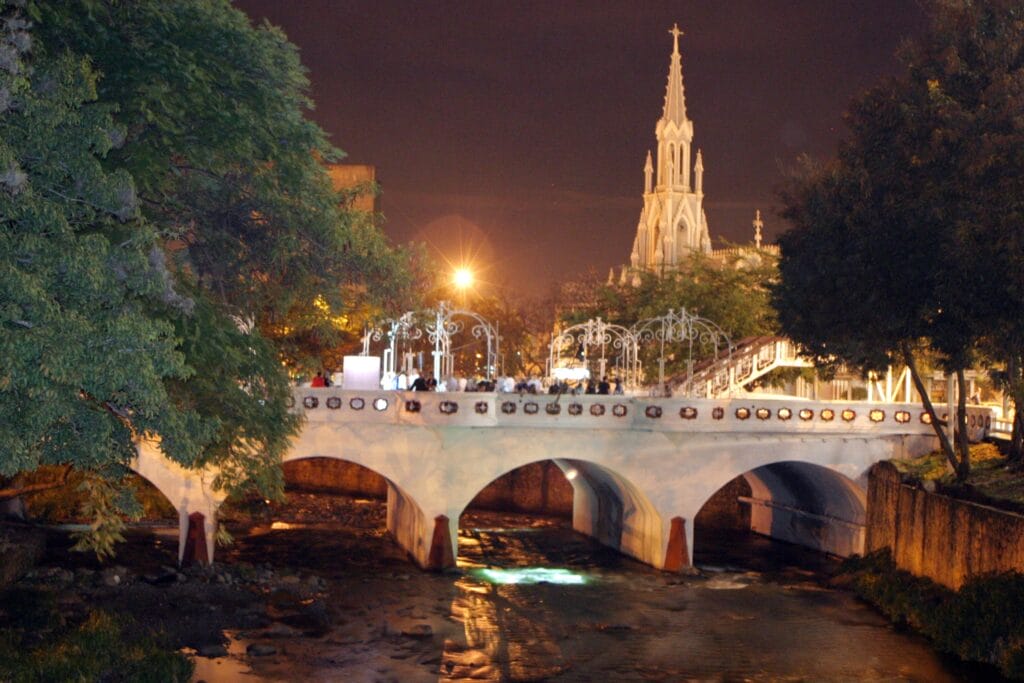
Several art collectives emerge in Cali as a strategy to cope with limited spaces to exhibit contemporary art.
2004
History
From 2004 to 2006 several paramilitary groups demobilize, including the AUC.
Art/Culture
Muñoz wins First Prize at the XXXIX National Salon of Artists of Colombia with his video Portrait/I Try Again. The artist is included in the exhibition Retratos: 2000 Years of Latin American Portraiture that opens at the Museo del Barrio in New York and then travels to the San Diego Museum of Art. In Cali, the art collective Casa Tomada (Occupied House) is founded by a group of young artists, including Lina Hincapié, Luis Mosquera, Mónica Restrepo, and Carolina Ruiz. Active until 2007, the group, for short periods, takes over abandoned houses in different parts of the city to present work by young artists, among other projects. Also, the art collective Descarrilados (Derailed), is formed by students of the School of Visual Arts of the Institute of Popular Culture of Cali. Its members are Jaes Caicedo Castillo, Gonzalo González Barreiro, Viviana Andrea Guarnizo Mejía, Florencia Mora Anto, and Diana Carolina Torres. Since their first project, Drunkards Train, the group, still active, uses three abandoned train cars transported to various sites as exhibition and meeting spaces.13
The Artist
Lugar a Dudas receives funding from international entities such as the Daros Latinoamérica and Prince Claus Fund, a cultural organization in Amsterdam created to honor His Royal Highness, the late Prince Claus of The Netherlands. Muñoz supplements their support with funds from his National Salon of Artists of Colombia award.14 He creates the six drawings of Intervals (While I Breathe), by burning a dot matrix into paper with a cigarette. The exhibition Ambulatory-Portrait/I Try Again is presented at the Sicardi Gallery in Houston as part of the art fair FotoFest 2004.
Muñoz begins to work on the project Bycontact Archive, which will take different forms over the next five years. Based on the archive by Cali fotocineros, purchased in 1976, this collection continues to grow through photographs submitted by the people of Cali. From November 4–6, Muñoz presents the urban intervention piece El puente (The Bridge) at the Ortiz Bridge in Cali, with photos that are part of the Bycontact Archive. The piece consists of digitally projecting one hundred images from the archive on the waters of the Cali River that flow under this bridge.
2005
History
A constitutional reform, pushed by President Uribe, allows presidents to be reelected. The “Law of Justice and Peace” is promoted by the Uribe administration, approved by Congress, and refined by a Constitutional Court. It facilitates the demobilization of paramilitary groups, including the AUC. Around 53,000 combatants demobilize between 2002 and 2010.
Art/Culture
Directed by Oscar Muñoz and Sally Mizrachi, Lugar a Dudas officially opens in Cali to the public as a venue for exploring different disciplines and formats, including photography, publications, music, and theater.15 It is located in the neighborhood of Granada, a commercial area with an interest in revitalizing nineteenth-century buildings. Lugar a Dudas fosters encounters through calls for exhibition proposals, artistic and curatorial residencies, film series, and free consultation of library and archival materials. Young artists can gather there to work through ideas and participate in public dialogue about art and politics.16 This art center begins activities in April with a show of experimental Latin American video art, L.A Freewaves, produced by Juan Devis. It also offers on-going film series in connection with Cine Club Caligari, curated by Oscar Campo, a professor at the School of Social Communication, at the University of Valle, Cali. Slowly Lugar, a Dudas establishes links with other institutions abroad. The short-lived Cali art collective El Camión (The Truck) shows work by young artists in a truck parked outside art galleries or museums during their exhibition openings. Members include Lisseth Balcázar, Adrian Felipe Gaitan, Carolina Ruiz Torres, Daniel Tejada Tabares, Jimmy Villegas, and Sergio Andrés Zapata.
The Artist
Muñoz’s exhibition Project for a Memorial presents five videos showing the artist’s hand as he attempts to draw portraits of men and women he found in the obituary pages of Colombian newspapers with water on warm cement. It is shown in Bogotá, Los Angeles, Chicago, Barcelona, and Venice, at the 51st Venice Biennale. He teaches classes in Lugar a Dudas for advanced students from the Departmental School of Fine Arts, focusing on how to develop an artistic practice.
2006
History
Álvaro Uribe is reelected President of Colombia until 2010. During his administration, stability continues to improve, with lower unemployment and an increase in foreign investment and economic growth. However, international agencies accuse Uribe of human rights violations and creating an illegal network of informants. The Colombian army kills thousands of innocent civilians to claim that the bodies are those of guerrillas. Their objective is to show the efficacy of Uribe’s policies against armed insurgents. The media calls the scandal “the false positives.”
Art/Culture
For more than a decade (2006-2017), Cali art collective Circular Contemporánea (Contemporary Circular), which includes members Adrián Gaitán, Daniel Tejada, Iván Tovar, and Sergio Zapata, fosters more than thirty exhibitions, several in domestic spaces.17
The Artist
In the video Line of Destiny, Muñoz continues his experimentation with water as an artistic medium. It shows the palm of a hand holding water, on which his face is reflected until the liquid drains away. From May to June he opens the exhibition Oscar Muñoz: Dissolvings and Phantasmagories at the Municipal Museum of Guayaquil, Ecuador. Oscar Muñoz: Biographies is shown at the Cloister of the Convent of Santa Clara, Cartagena, Colombia. Muñoz begins to produce the video Sand Man, featuring a sand-drawn figure that attempts to escape from the incoming sea.
2007
History
With the capture of the leaders of the Norte del Valle Cartel, which includes Cali, the organization breaks down into smaller groups known as “emerging criminal bands” (BACRIM). In July, hundreds of thousands of people protest in Bogotá against kidnappings, calling for an end to the armed conflict. In November, Venezuelan President Hugo Chavez serves as mediator between armed insurgents and the Colombian government for the release of hostages.
Art/Culture
Doris Salcedo creates Shibboleth at the Tate Modern gallery in London, a series sponsored by Unilever. Muñoz is invited to participate at the 52nd Venice Biennial, curated by Robert Storr. Muñoz’s work is also featured in the traveling exhibition The Disappeared/Los Desaparecidos, shown in the United States in the cities of New York; Santa Fe, New Mexico; Washington, D.C.; Laramie, Wyoming; and Grand Forks, North Dakota. In Latin America, the exhibition is presented in Argentina, Uruguay, Chile, Guatemala, and Colombia (until 2009). At the International Encounter of Medellín, dedicated to “Local Histories, Global Practices,” Muñoz is part of the curatorial team of the Host Spaces nodule that takes place at the Museum of Antioquia, inviting four local art collectives and hosting eight foreign ones. Colombian artist Mónica Restrepo joins Lugar a Dudas as Coordinator of the Center for Documentation. The film retrospective Movie Valley, featuring the most important films made in the region, is presented at Lugar a Dudas, with an introduction by Ramiro Arbeláez, professor at the University of Valle in Cali.
The Artist
In his installation Countrytime, Muñoz produces a dot matrix with a pyro engraving tool on newsprint. The piece consists of eighteen issues of two leading newspapers El País (Cali) and El Tiempo (Bogotá). Each issue comprises ten bound pages, with each page becoming progressively illegible as the text dissolves into fainter dots—a metaphor for the obsolescence of the news cycle. According to Muñoz, “Countrytime is an archive that does not circulate information, at least not the way a newspaper does; it transmits feelings, a certain unpleasant state of mind, a sense of unease… The news repeat from page to page until they become almost imperceptible marks on the paper. These are first pages of newspapers that I kept because somehow, they caught my attention, on account of their layout, the phrases they repeat, because they belong to the present but feel like we already read them long ago. They give me a sensation that is difficult to explain with words. I think of Wittgenstein’s phrase: ‘My grief is no longer the same; a memory which was still unbearable to me a year ago, is now no longer so.’”18 In his piece Game of Probabilities, Muñoz weaves fragments of photographs of his own face, both in black and white and color, to produce nine collages. He presents Bycontact Archive as an installation with six digital impressions over tables and a lithographed poster.
2008
History
The FARC release two high-profile hostages, Clara Rojas and Consuelo Gonzalez, and fifteen are later rescued by the Colombian Army, including Senator Ingrid Betancourt. These guerillas attack Cali’s Palace of Justice several times from 2008 to 2010. Serious accusations of corruption are leveled against several congressmen who approved the constitutional reform of 2005 that allows the reelection of the President of Colombia. Colombia extradites fourteen paramilitary leaders to the United States to stand trial on drug trafficking charges. Cali begins urban renewal with the total demolition of the neighborhoods of Calvario, San Pascual, and Sucre. The new neighborhood, around twenty blocks with commercial and residential areas, is called Ciudad Paraíso. This project has not yet been completed.
Art/Culture
The XLI National Salon of Artists of Colombia takes place in Cali, curated by local artists Wilson Díaz, José Horacio Martínez, Oscar Muñoz, and Bernardo Ortiz, and the Argentine curator Victoria Noorthoorn. It involves numerous arts organizations in the city.
The Artist
From 2008 to 2010, Muñoz works on his installation Through the Glass, which includes videos of family photographs borrowed from the people of Cali. The videos, which capture the images along with the reflections on the glass, are shown on small screens set within frames identical to those of the original photos.
The retrospective exhibition Oscar Muñoz: Documents of Amnesia is presented at the Extremaduran and Iberian-American Museum of Contemporary Art, Badajoz, Spain. Oscar Muñoz: Mirror Image travels to the Institute of International Visual Arts, London; and Perth Institute of Contemporary Arts, Australia (until 2009). Muñoz’s exhibition Imprints for a Fleeting Memorial is presented at the following venues (until 2012): the 1708 Gallery in partnership with the Visual Arts Center, both in Richmond, Virginia; Southeastern Center for Contemporary Art, Winston-Salem, North Carolina; La Galerie de I’UQAM, Montreal; and Prefix Institute of Contemporary Art, Toronto.
2009
History
Cali opens the Occidental Integrated Massive (MIO), a rapid transit bus system that reaches new sectors of the city. The FARC release several high-profile hostages. Colombia signs a deal with the United States, giving it access to several Colombian military bases.
The Artist
In the video Fade to White (Two Portraits), Muñoz presents his father with a photo of his mother in the background. The strong light illuminating the image is a reference to the local sunlight of Cali that is sometimes strong enough to eliminate details. Muñoz creates Before the Image by engraving on ten mirrors mounted in aluminum an image of the first photographic self-portrait of 1839 by Robert Cornelius. Each mirror also reflects the face of the viewer when observing the piece. Editorial house Laguna Libros publishes Muñoz’s artist’s book, Bycontact Archive, featuring the images taken by unknown street photographers in Cali during the 1960s and 1970s. On the cover is an image of the Olympus Pen camera these photographers often used.
1 Alexander Castillo Garcés and Ana María Betancourt Ledezma, “Violencia y políticas de seguridad en la ciudad de Cali–Colombia,” Summa Iuris, vol. 5, no. 2, July–December, 2017: 303. Digital Object Identifier (DOI): <https://doi.org/10.21501/23394536.2598>.
2 Maria Iovino, Oscar Muñoz: volverse aire (Bogotá: Eco, 2003), 58–61.
3 Muñoz, cited in Diego Garzón, Otras voces, otro arte: diez conversaciones con artistas colombianos (Bogotá: Planeta, 2005),65.
4 Iovino, Oscar Muñoz, 67–69.
5 Muñoz, cited in Garzón, Otras voces, otro arte, 67.
6 Iovino, Oscar Muñoz, 62–64.
7 María Margarita Malagón, “Art as Indexical Presence, The Work of Three Colombian Artists in Times of Violence: Beatriz González, Oscar Muñoz and Doris Salcedo in the 1990s,” doctoral dissertation, The University of Texas at Austin, 2006, 65–66.
8 Muñoz, cited in Carlos Jiménez, et al., Oscar Muñoz: Documentos de la amnesia (Badajoz: Museo Extremeño e Iberoamericano de Arte Contemporáneo, 2008), 106.
9 María Wills, “Entrevista retrospectiva a Oscar Muñoz,” banrepcultural.org <https://www.banrepcultural.org/oscar-munoz/entrevista-memorias-infancia-juventud.html>, accessed January 28, 2020.
10 Muñoz, cited in Malagón, “Art as Indexical Presence,” 123n326.
11 Muñoz, cited in Wills, “Entrevista retrospectiva.”
12 Muñoz, cited in Garzón, Otras voces, otro arte, 69.
13 Blanca de la Torre, “Cali: La unión hace la fuerza,” Citas y sitios, Colección Cisneros website, posted January 21, 2015; accessed May 14, 2020.
14 Alejandra Condes Potes and Natalie Mancilla Solarte, “Como se han transformado los espacios de exhibición para las artes plásticas en Cali: Fundación ‘Lugar a Dudas’ (2003–2008),” undergraduate thesis, Universidad Autónoma de Occidente, Facultad de Comunicaciones, 2009, 36.
15 Escuela incierta, website: https://www.escuelaincierta.org/about-1, consultado 01/05/2020.
16 Wills, “Entrevista retrospectiva”.
17 Blanca de la Torre, “Cali: La unión hace la fuerza,” Citas y sitios, Colección Cisneros website, posted January 21, 2015; accessed May 14, 2020.
18 Muñoz, cited in Wills, “Entrevista retrospectiva.”

